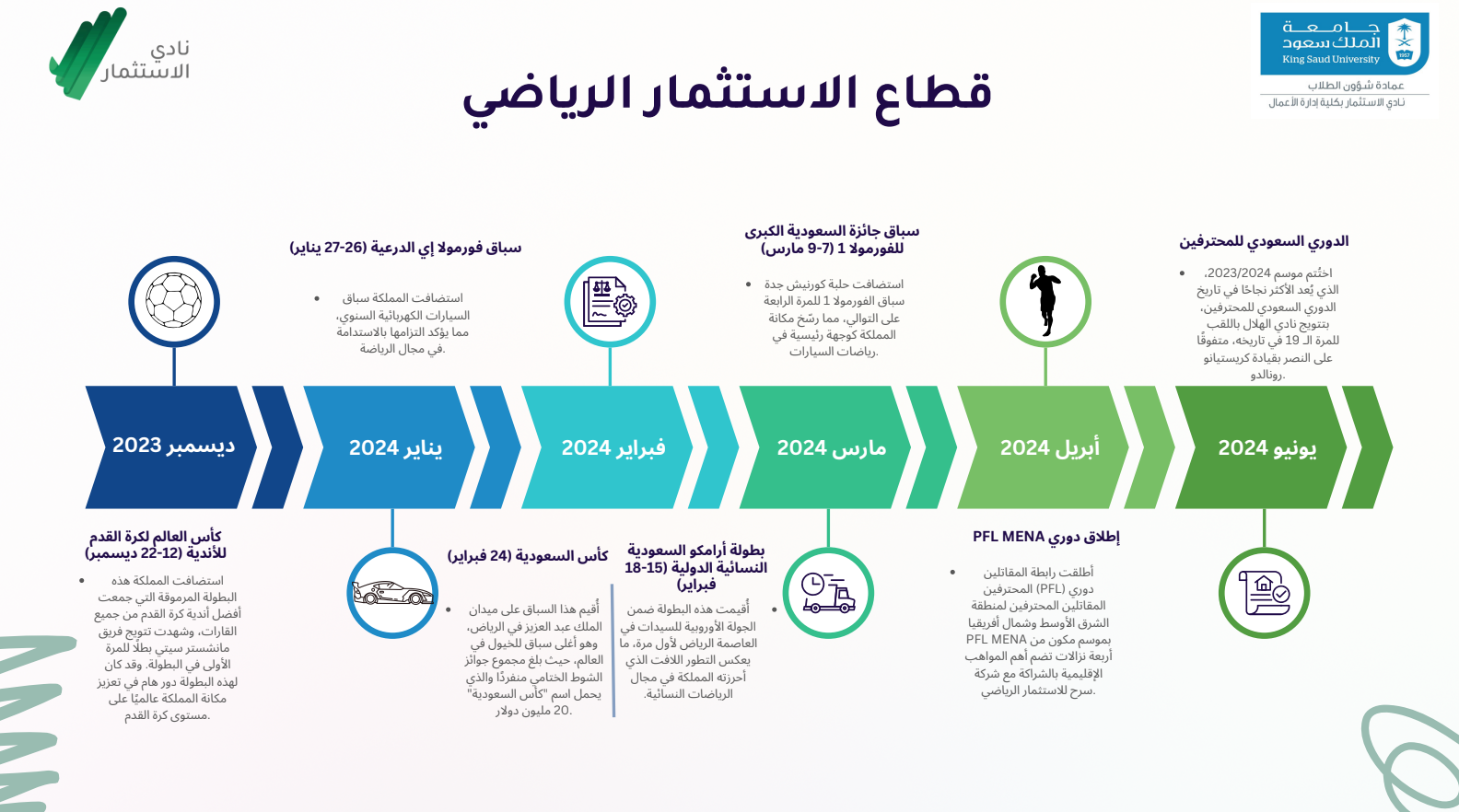Sports Sector

Investments are taking off! The sports sector has gone beyond being merely a competitive or recreational activity to become a massive industry today, attracting investors on a global level.
Since the year two thousand and nineteen, the Kingdom has hosted more than one hundred international events across forty different sports, reinforcing its position and attracting the world's top athletes and the attention of global audiences.
The year two thousand and twenty-four witnessed significant transformations in the global sports industry, as Saudi Arabia continued to strengthen its presence with an ambitious vision. By the end of the year, the Kingdom achieved a historic milestone by securing the hosting rights for the two thousand and thirty-four FIFA World Cup, reaffirming its status as a leading global sports hub capable of hosting the world's most prestigious tournaments.

Saudi Arabia’s approach is not limited to hosting prominent events but also focuses on enhancing a thriving sports culture. This contributes to increased local participation in sports and supports the nurturing of athletic talents while strengthening its global presence.
These efforts align with Saudi Vision twenty thirty, reflecting the Kingdom’s commitment to economic diversification and enhancing its international presence. The sports sector plays a vital role as a key driver of economic growth, job creation, and women’s empowerment in Saudi Arabia.
Since the beginning of the year two thousand and twenty-one, Saudi Arabia has spent no less than six point three billion dollars on sports deals, doubling its previous six-year expenditure, according to the British newspaper "The Guardian."
The contribution of the sports sector to the Gross Domestic Product (GDP) increased from two point four billion dollars in the year two thousand and sixteen to nine point six billion dollars in the year two thousand and nineteen. By the year two thousand and thirty, the sector’s annual contribution is expected to reach sixteen point five billion dollars, representing one point five percent of the total GDP.
Currently, the sports sector provides employment opportunities for fourteen thousand people. Thanks to new programs, the sports sector has witnessed a one hundred and twenty-nine percent increase in employment.
An annual budget of two billion dollars is allocated for the development of the sports sector. The United Kingdom, for comparison, allocates six hundred and seventy million dollars annually for the sector. By the year two thousand and twenty-eight, a total of two point seven billion dollars is planned for the construction of new sports facilities and the renovation of existing ones.
In the year two thousand and twenty-three, Saudi clubs spent a total of nine hundred and fifty-seven million dollars on new contracts. Saudi Arabia recorded a net spending of nine hundred and seven million dollars on foreign player recruitment, ranking as the second-highest global league in spending after the English Premier League.
There are currently forty national women’s teams in twenty-five different sports federations. More than four hundred thousand women participate annually in sports activities. Before Saudi Vision twenty thirty, there were no female presidents in sports federations; today, there are seven.
One hundred and four women hold positions on the boards of sports federations, representing thirty percent of leadership roles. Women made up one-third of participants in the two thousand and twenty-four Saudi marathon. More than three hundred and thirty female athletes are registered across various sports fields, including referees, coaches, and specialists.
Saudi Arabia has transformed the sports industry into a key economic driver, achieving measurable progress in global rankings. Highlighted achievements in the sports sector in the years two thousand and twenty-three and two thousand and twenty-four include:


Saudi Arabia has emerged as a global powerhouse in e-sports, with investments surpassing thirty-eight billion dollars and an anticipated contribution of thirteen point three billion dollars to the GDP by the year two thousand and thirty. Additionally, Saudi Arabia hosted the FIFAe World Cup with prizes worth one hundred and twenty million dollars and launched investment funds valued at sixty-two point five million dollars to support the e-sports industry.
The number of sports arenas increased significantly, reaching one thousand and ninety-seven, marking a thirty percent rise. In some parts of the United Kingdom, female participation reached fifty percent of total athletes.
Since the year two thousand and nineteen, the number of registered athletes in Saudi Arabia has grown by forty-six percent, reaching two thousand three hundred players, with training provided to five hundred and five specialized coaches and one hundred and eighty-two referees.
Saudi Arabia advanced in the global rankings for women’s football, climbing from one hundred and seventy-five to sixty-five, an eighty-six percent improvement. A budget of thirteen million dollars has been allocated for women’s teams and female participation in sports.
Sports are no longer just about physical activity; they also foster social connections and enhance cultural ties. Through local and international tournaments, sports enable people to interact and engage with different cultural perspectives.
Saudi Arabia’s sports sector is entering a new phase of achievements. The Kingdom continues to push beyond previous limits, moving towards a more ambitious and transformative future in sports.
Prepared by:
Ghaida
Lujain
Waleed
Sources:
The Guardian
Sports Investment Reports